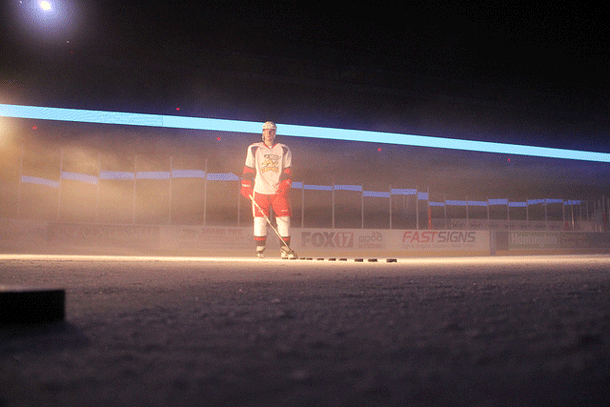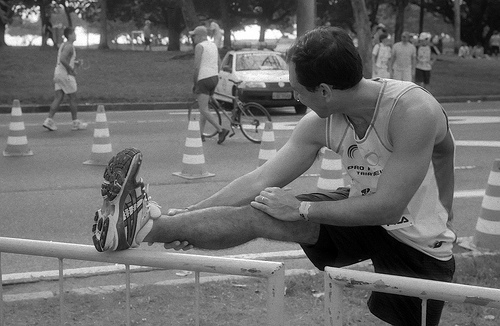Grand Rapids Griffins strength and conditioning coach Marcus Kinney honed his skills in a number of locations, including the U.S. Naval Academy and Kansas State University, before working with professional hockey players. Throughout his career, he has worked with athletes at all experience levels that are training for competency in a wide variety of sports.
As the strength coach for the Griffins, Marcus is an expert at prescribing the conditioning work hockey players are required to do off the ice in order to be most effective on the ice. He recommends that hockey players spend one hour in the weight room at least two days each week. And, while they’re lifting weights, Marcus has a list of five key things that every hockey player should be focusing on.
1. Balanced Body Development
For the most part, hockey players are comparatively weak through the upper bodies since their sport demands a lot of activity from their lower bodies. Because the upper body requirements of hockey involve a lot of pushing from the shoulder and chest muscles, young hockey players tend to focus on their chest when they hit the weight room. According to Marcus, this is a huge mistake.
“If you’re going to do an upper body push, you have to do an upper body pull to maintain your body’s balance,” Marcus said. “The backside of the body provides a lot of support, and that permits the front side to operate more efficiently. At a minimum, hockey players should be doing at least one pressing motion and one pulling motion in the weight room, along with leg movements like squats, lunges, Romanian deadlifts and leg curls.”
2. Lower Body Stretching
Hockey tends to keep players in a crouched position, which puts a lot of pressure on the hip flexors. Over time, this actually results in the angle of the pelvis becoming altered, which can cause lots of functional problems. This is why Mike always stresses the importance of stretching to the athletes he trains.
“One of the 30-year-old guys on our team was considering retirement at the end of last season, in part because he was having problems with his hips,” Mike explained. “We got him involved with light yoga a couple times a week, and the added flexibility he gained had him feeling far more comfortable out on the ice. He came to us and explained that he feels like he can squeeze another season out of his body now that he did the stretching associated with yoga, so stretching can actually extend players’ careers once they add flexibility to their bodies.”
3. Prehabilitation
Every time a player swings a hockey stick, he puts his shoulders in a precarious position and creates the potential for an injury. Likewise, players’ ankles are stuffed into boots, and this tends to weaken the ankles, and result in high ankle sprains. Mike says that it’s important to focus on the body’s most vulnerable areas ahead of time to avoid suffering through injuries later on.
“Players should do stability exercises for the ankles and knees to avoid those high ankle sprain injuries,” Mike advised. “Likewise, the mobility of the shoulder is offset by its instability. So the rotator cuff muscles and the muscles that stabilize the scapula need to be worked in order keep the shoulders from suffering a debilitating injury.”
4. Explosive Plyometric Movements
Hockey players perform a number of explosive movements over the course of the game, and those movements can be enhanced with plyometric training in the weight room. Mike contends that these movements prepare players’ bodies for the in-game situations that ask players to exert instantaneous force on their legs, the puck, or their opponents.
“Players need the ability to load up a muscle and unload it quickly while they’re out there competing,” Mike said. “They need to develop that with plyometric exercises for both the upper body and lower body. Clap pushups and jumping exercises will help give players that extra edge they need.”
5. Functional Balance Training
The ice during a hockey game is a unique environment, where opposing players are always trying to knock the athlete off balance. Mike suggests stability exercises as a means of developing functional balance. This will allow players to absorb the hits and keep moving forward.
“We usually tend to have an athlete do things on an unstable apparatus, like a stability ball or a Swiss ball,” Mike said. “This will enhance their ability to control their core and create the functional balance they need. Sitting on a stability ball and lifting your heels off the ground, or kneeling on a stability ball and working your way to a standing position are exercises that allow hockey players to adapt to the subtle shifts when someone tries to knock them off balance.”
Interested in Hockey? Check out the Meijer State Games - Hockey Information
The Meijer State Games of Michigan is a multi-sport, Olympic-style event(s) that welcome athletes regardless of age or ability level. The Games embody the values of participation, sportsmanship and healthy living.
Interested in our Summer Games?
www.StateGamesofMichigan.com/summergames
Interested in our Winter Games?
www.StateGamesofMichigan.com/wintergames








